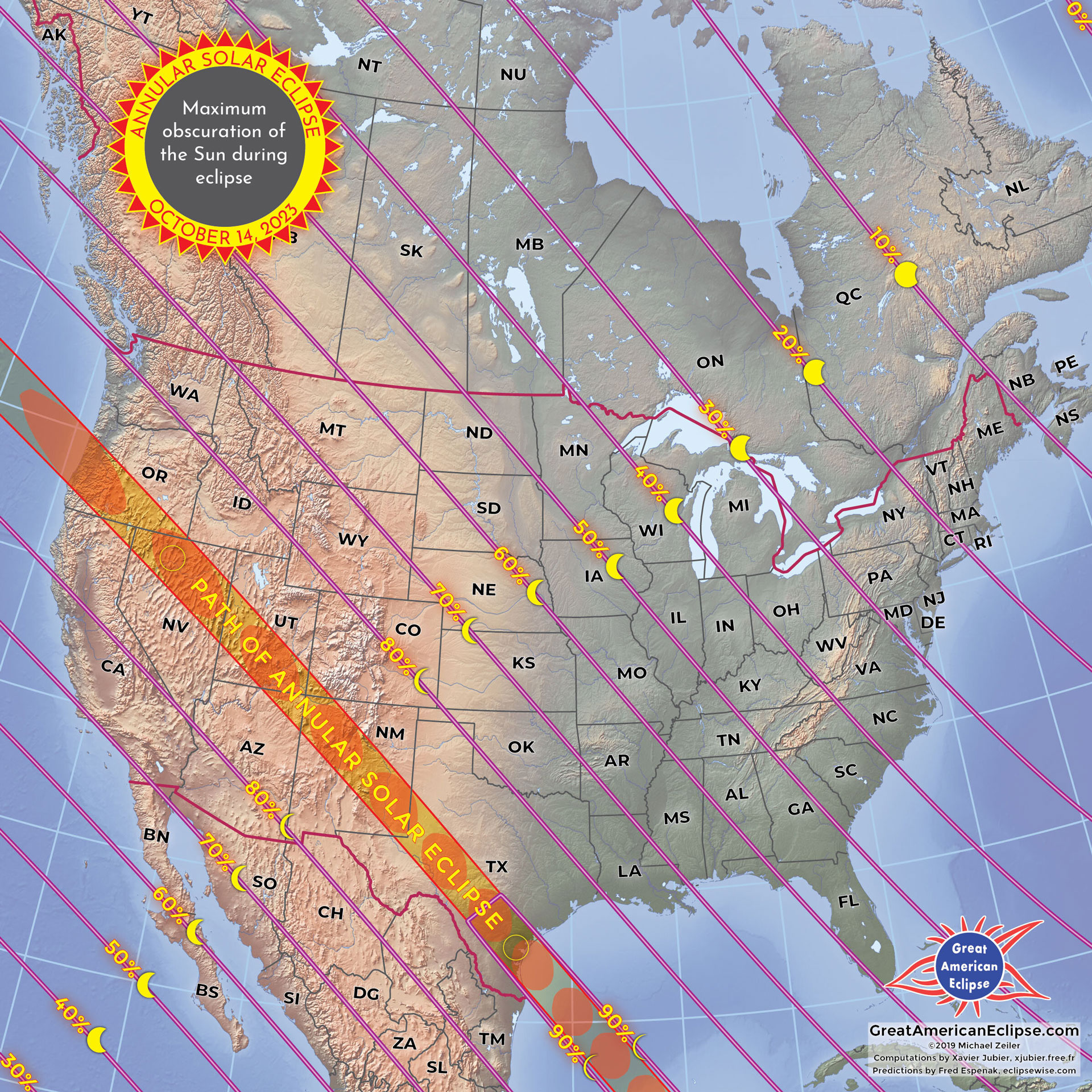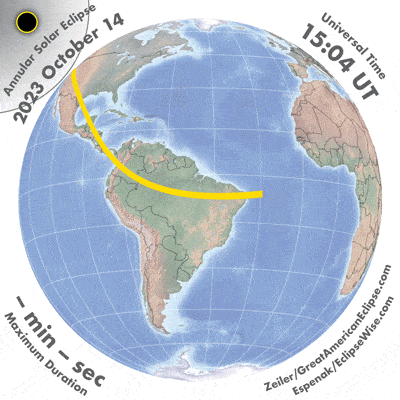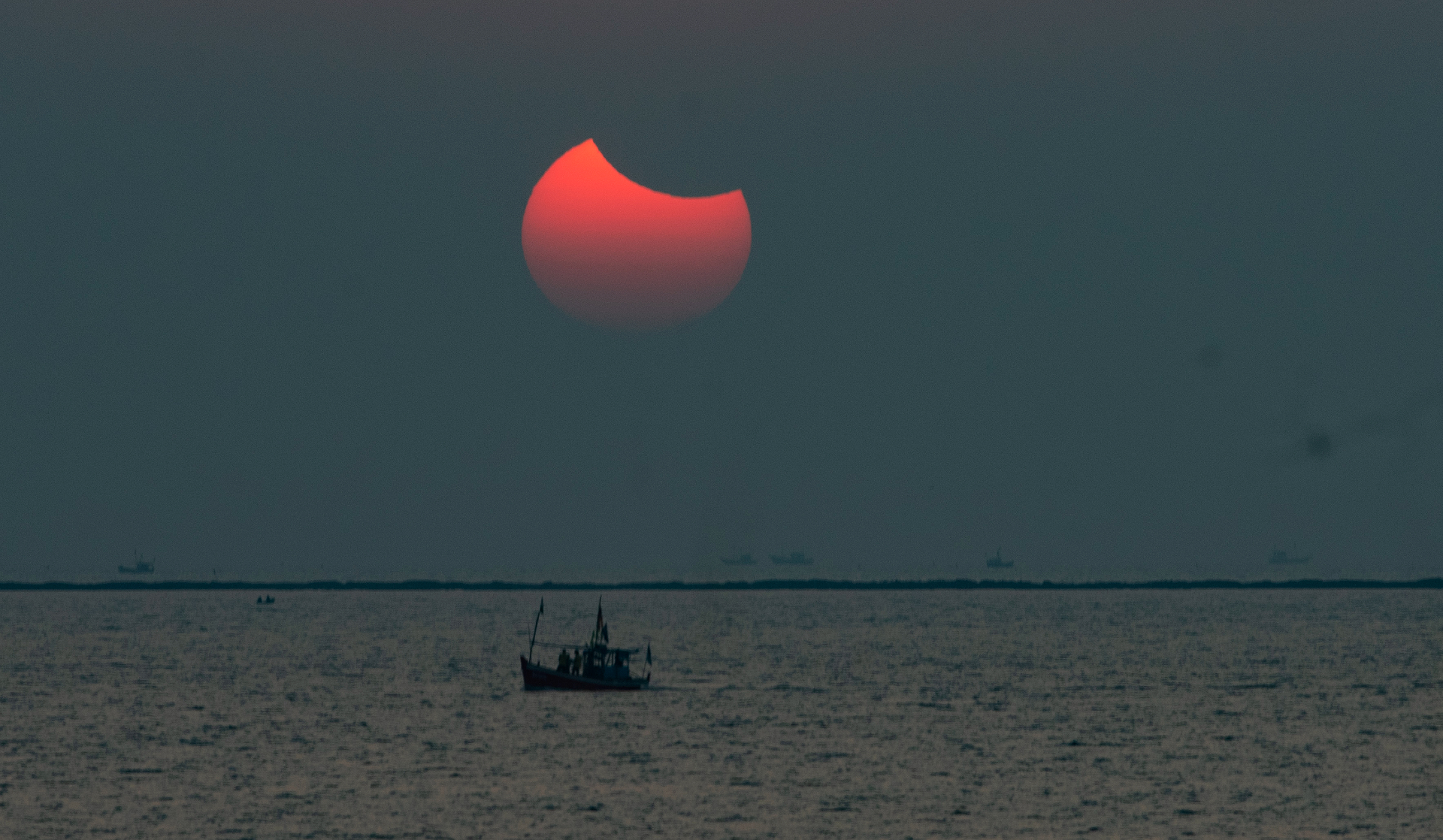Annular solar eclipse 2023: Everything you need to know about North America's 'ring of fire' eclipse
The annular solar eclipse will be visible from eight states in the U.S. Southwest.
Update for 3:45 p.m. ET: The annular solar eclipse of 2023 has completed its pass over the United States and moved into parts of Central America and South America. Read our wrap to see amazing photos and videos.
On Saturday, Oct. 14, 2023, an annular solar eclipse will come to North America.
We have summarized how you can watch the annular solar eclipse 2023 online and NASA has also released an interactive map where you can track the Oct. 14 annular solar eclipse down to the last second. The 'ring of fire' is not to be missed!
Roughly 11 years after the same type of solar eclipse crossed the U.S. Southwest on May 20, 2012, this one will be visible from a similar region, crossing eight U.S. states from Oregon to Texas, according to NASA.
During an annular solar eclipse, the moon appears slightly smaller than the sun, so it can't block the entire disk. The result is a beautiful "ring of fire." Here's everything you need to know about this rare event.
Related: Which U.S. states will October's 'ring of fire' solar eclipse be visible from?
What is an annular solar eclipse?
This eclipse won't darken skies the way the total solar eclipse of Aug. 21, 2017, did. A solar eclipse occurs when a new moon is positioned precisely between Earth and the sun and casts its shadow on Earth.
Breaking space news, the latest updates on rocket launches, skywatching events and more!
An annular solar eclipse happens when the moon appears relatively small in the sky so does not fully cover the disk of the sun, leaving a thin outer ring often called a "ring of fire."
Whether the moon can completely cover the sun's disk depends on the moon's distance from Earth. The moon has a slightly elliptical orbit around Earth, so at two points each month, it is farthest (apogee) and closest (perigee) to Earth, making the moon appear slightly smaller and slightly larger than average in our sky.
On Oct. 14, 2023, the new moon will look relatively small and, therefore, cover only 91% of the sun's disk as viewed from the narrow path of annularity that stretches from Oregon through Texas and beyond.
Related: 10 best events across the US to celebrate the Oct. 14 annular solar eclipse
Where is the annular solar eclipse "ring of fire"?
On Oct. 14, 2023, all of North America and Central America, and most of South America will experience a solar eclipse. For all of that region, the spectacle will be a partial solar eclipse of varying obscuration. Only within the path of annularity, which is 118 to 137 miles (190 to 220 kilometers) wide, will the ring of fire be visible. That path will stretch from Oregon through northern California, northeast Nevada, central Utah, northeast Arizona, southwest Colorado, central New Mexico and southern Texas. It will then move across the Gulf of Mexico and over Mexico, Guatemala, Belize, Honduras, Nicaragua, Costa Rica, Panama, Colombia and Brazil.
The point of greatest eclipse — where viewers could see a ring of fire lasting 5 minutes, 17 seconds — will occur off the coast of Nicaragua and Costa Rica. To see the exact path of annularity, check out this interactive map created by French eclipse expert Xavier Jubier.
Where to watch the annular solar eclipse "ring of fire" in North America
In Sept. 2023, it was announced that all Navajo Tribal Parks will be closed from 8:00 a.m. until 1:00 p.m. MDT on October 14, 2023, due to Navajo cultural beliefs surrounding the event. This includes Monument Valley Navajo Tribal Park, Four Corners Monument Navajo Tribal Park and parts of the Tséyi’ Diné Heritage Area in Canyon de Chelly National Monument. Local businesses may also be closed. Please plan your eclipse viewing trip accordingly.
The most scenic places to see the ring of fire are in the U.S. Southwest and at the Mayan temple at Edzná on Mexico's Yucatán Peninsula. Here are some notable locations and cities that will see a ring of fire, together with the local time and duration of that event, according to Jubier. Note that all of these places will also see a long partial solar eclipse before and after the brief 'ring of fire; their closeness to the centerline of the path of annularity determines the duration of the ring of fire:
- Oregon Dunes, Oregon: 9:15 a.m. PDT; 4 minutes, 29 seconds
- Crater Lake National Park, Oregon: 9:17 a.m. PDT; 4 minutes, 19 seconds
- Lava Beds National Monument, California: 9:19 a.m. PDT; 54 seconds
- Great Basin National Park, Nevada: 9:24 a.m. PDT; 3 minutes, 46 seconds
- Bryce Canyon National Park, Utah: 10:27 a.m. MDT; 2 minutes, 31 seconds
- Capitol Reef National Park, Utah: 10:27 a.m. MDT; 4 minutes, 37 seconds
- Canyonlands National Park, Utah: 10:29 a.m. MDT; 2 minutes, 24 seconds
- Natural Bridges National Monument, Utah: 10:29 a.m. MDT; 4 minutes, 29 seconds
- Mesa Verde National Park, Colorado: 10:31 a.m. MDT; 2 minutes, 57 seconds
- Chaco Culture National Park, New Mexico: 10:32 a.m. MDT; 4 minutes, 42 seconds
- Albuquerque, New Mexico: 10:34 a.m. MDT; 4 minutes, 42 seconds
- San Antonio: 11:52 a.m. CDT; 4 minutes, 5 seconds
- Corpus Christi, Texas: 11:55 a.m. CDT; 4 minutes, 52 seconds
- Padre Island National Seashore, Texas: 11:56 a.m. CDT; 4 minutes, 52 seconds
- Edzná Maya archaeological site, Yucatán Peninsula, Mexico: 11:23 a.m. CST; 4 minutes, 32 seconds
Although it's a great excuse to visit new places, the most important factor for eclipse viewing is clear weather. Check the climate and weather before you make a plan, and be prepared to change your location when the local short-term weather forecasts arrive.
Related: Annular solar eclipse 2023: How to watch in person and online
Why will the 2023 annular solar eclipse be so special?
Although it's largely being seen as a warm-up for the 2024 total solar eclipse, the 2023 annular solar eclipse is a great excuse to travel, and for eclipse chasers who have yet to see an annular solar eclipse, it's a great opportunity.
As with all eclipses, it's important to be in the center of the path of the moon's shadow if you want to experience as long a spectacle as possible. That means putting yourself on or near to the centerline. However, experienced eclipse chasers will head to the northern edge of the path — at locations such as Dolores, Colorado, and Santa Fe, New Mexico — to experience a much shorter, but arguably more dramatic, spectacle.
Viewers in these locations will see a ring of fire for perhaps just a few seconds. But it will be less circular, and one part of the edge of the moon will appear to almost block out the sun. This may make it possible to glimpse the "Baily's beads" ring around the moon during the annularity phase, just as can be seen during a total solar eclipse.
Where to see the partial solar eclipse
Although the ring of fire will get a lot of attention, few people make much effort to travel to see an annular solar eclipse. After all, these events don't quite compare to total solar eclipses. On Oct. 14, 2023, most of the Americas will experience a big partial solar eclipse. Here is what the 10 biggest cities in the U.S. will experience that day; only one will see the ring of fire:
- New York: 23% at 1:22 p.m. EDT
- Los Angeles: 71% at 9:24 a.m. PDT
- Chicago: 43% at 11:58 a.m. CDT
- Houston: 85% at 11:58 a.m. CDT
- Phoenix: 79% at 9:31 a.m. MST
- Philadelphia: 25% at 1:21 p.m. EDT
- San Antonio: "Ring of fire" at 11:52 a.m. CDT
- San Diego: 68% a.m. at 9:26 PDT
- Dallas: 80% at 11:52 a.m. CDT
- San Jose, California: 75% at 9:20 a.m. PDT
How to safely view the partial and annular solar eclipse
To safely view this event, you must use solar filters at all times. Whether your location will experience a partial solar eclipse or an annular solar eclipse, the dangers are the same. In fact, a "ring of fire" is technically nothing more than a particularly pretty partial solar eclipse, because at no point will more than 91% of the sun's disk be covered by the new moon. Observers will need to wear solar eclipse glasses, and cameras, telescopes and binoculars must have solar filters placed in front of their lenses at all times.
Our how to observe the sun safely guide tells you everything you need to know about safe solar observations.
When is the next annular solar eclipse ring of fire?
After the annular solar eclipse on Oct. 14, 2023, the next annular solar eclipse will occur on Oct. 2, 2024, when a ring of fire will be visible from the Pacific Ocean, southern Chile and southern Argentina. At the point of greatest eclipse in the ocean, the ring of fire will last 7 minutes, 25 seconds, but the best spot will be Easter Island (Rapa Nui), located about 2,000 miles (3,200 km) off the western coast of Chile. There, it will be possible to stand among the remote volcanic island's many carved moai statues and see a ring of fire for up to 6 minutes, 9 seconds.
Additional resources
Want to look further ahead? You can find a concise summary of solar eclipses out to 2030 on NASA's eclipse website. Read more about solar and lunar eclipses on Eclipse Wise, a website dedicated to predictions of eclipses, and find beautiful maps on eclipse cartographer Michael Zeiler's GreatAmericanEclipse.com and interactive Google Maps on Xavier Jubier's eclipse website. You can find climate and weather predictions by meteorologist Jay Anderson on Eclipsophile.com.
If you capture a photo of the annular eclipse and would like to share it with Space.com's readers, send your photo(s), comments, and your name and location to spacephotos@space.com.
Bibliography
Espenak, F. (2013, December 9). Solar eclipses: 2021-2030. NASA. Retrieved February 12, 2023 from https://eclipse.gsfc.nasa.gov/SEdecade/SEdecade2021.html
Jubier, X. (n.d.). Solar eclipses: Interactive Google Maps. Retrieved February 12, 2023 from http://xjubier.free.fr/en/site_pages/SolarEclipsesGoogleMaps.html
NASA. (2022, December 21). October 14, 2023, solar eclipse. Retrieved February 12, 2023 from https://solarsystem.nasa.gov/eclipses/2023/oct-14-annular/overview/
Time and Date. (n.d.). October 14, 2023 - Great American Eclipse (annular solar eclipse). Retrieved February 12, 2023 from https://www.timeanddate.com/eclipse/solar/2023-october-14

Jamie is an experienced science, technology and travel journalist and stargazer who writes about exploring the night sky, solar and lunar eclipses, moon-gazing, astro-travel, astronomy and space exploration. He is the editor of WhenIsTheNextEclipse.com and author of A Stargazing Program For Beginners, and is a senior contributor at Forbes. His special skill is turning tech-babble into plain English.





